Numerical Modelling and Experimental Investigation of Medical Aerosols
The specific charge on a particle or a droplet plays an important role in transporting and depositing sprays and aerosols. When particles are inhaled they deposit within the respiratory system depending on their size, shape and charge and also breathing conditions as shown in Figure 1. Consequently the amount of electrical charge can significantly alter particles’ respiratory deposition.

Figure 1. Local deposition of inhaled 0.5μm diameter charged particles in the right-upper reconstructed airway model. Left: q=50e , Right: q=200e
Inhalation drug delivery devices available commercially can be classified into three main categories: Metered Dose Inhalers (MDIs), Dry Powder Inhalers (DPIs), and nebulizer inhalers. Although, over the years, the need for better clinical therapies and improved performance of the inhalers has led to several innovations and new designs in the respiratory drug delivery field the fundamental operation principles of these three the most popular types of inhalers have remained virtually unchanged. The MDIs are the most commonly used inhaler worldwide. The aerosol is created when a valve is opened allowing liquid propellant to spray out of a canister. Unlike MDIs, DPIs do not dispense a gas, rather a dry powder. The amount of the dose delivered to the lung is dependent upon the patients respiratory flow rate, or ability to inhale. Nebulisers convert liquid medication into a fine mist or aerosol so it can be inhaled through either a face mask or a mouthpiece
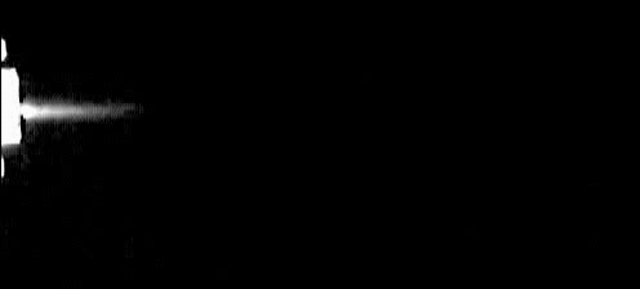
Figure 2. Aerosol plume taken using high speed camera.
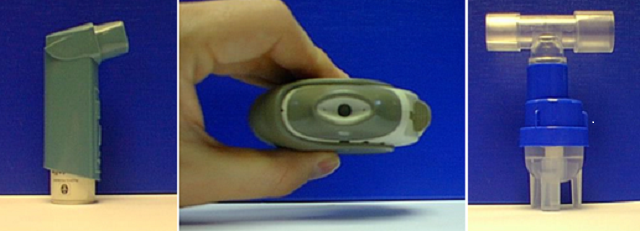
Figure 3. Aerosol drug delivery devices. Left: MDI, Middle: DPI, Right: Nebuliser.
The novel Bipolar Charge Measurement System (BCMS) was designed to provide fast, simultaneous measurement capability of the bipolar charge fractions on pharmaceutical aerosols delivered from medical dispensers, primarily in the particle size range between 0.5 to 10μm. The instrument employs the principle of particle separation by means of electric field acting perpendicular to the flow-field. The integrated particle flow bifurcator–separator is composed of two (“D” shape) sections incorporating three inner wire high voltage electrodes. A numerical method was developed using an extended commercial CFD code to calculate the particle deposition within the separator due to the combined effect of the flow field and the electric field. Based on the Lagrangian approach the trajectories of the particles were modelled considering electric and aerodynamic forces. The experimental validation of the numerical model was carried out using unipolarly and bipolarly charged aerosols generated from medical inhalers.
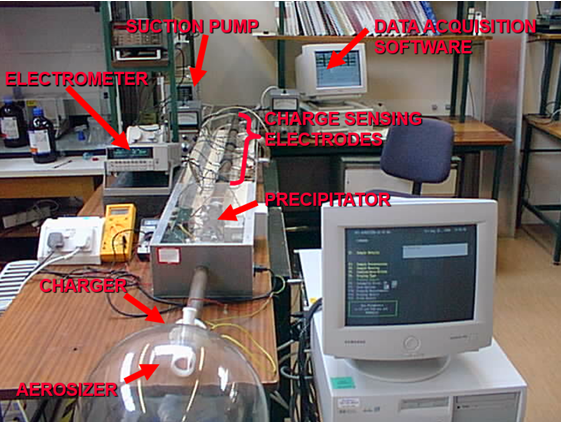
Figure 4. Bipolar Charge Measurement System.
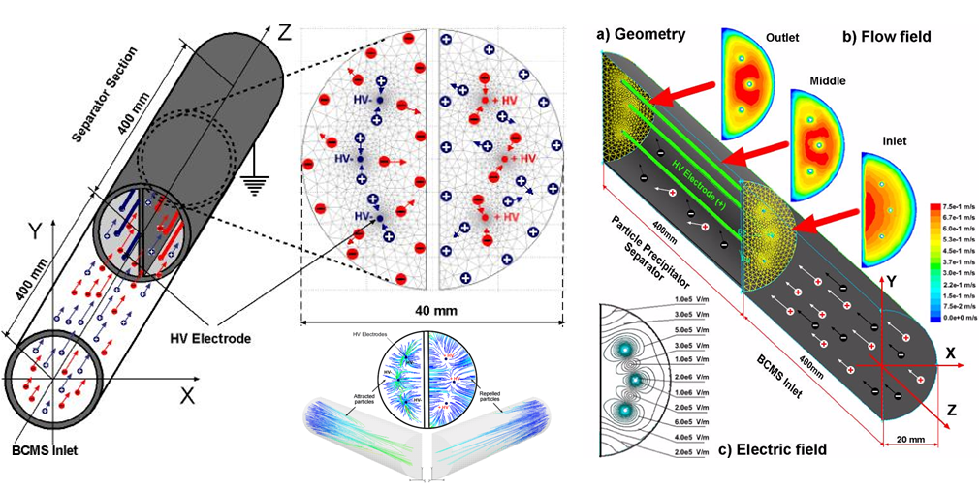
Figure 5. Left: Electrical field distribution obtained using FEMLAB, Right: The cross section of the half-tube of the bifurcation-precipitator device. The numerical solutions of the airflow were evaluated using FLUENT, which is based on the Finite Volume Method.
The experimental as well as the theoretical study presented in this chapter confirmed that the BCMS can be successfully used for measuring bipolar charge fractions on pharmaceutical aerosols delivered from MDIs, nebulizers as well as powder dispensers. The experimental results show that even though the net charge of the aerosol was relatively small, it could be composed of much larger bipolar charge fractions. The initial experimental tests with MDIs show that both the actuator and aerosol formulation have an effect on the bipolar charge distribution. The results obtained from pharmaceutical powders indicate that active drug component mixed with a carrier substance modifies the electrostatic properties of the powder sample and changes the balance between the total amount of positive and negative charge.
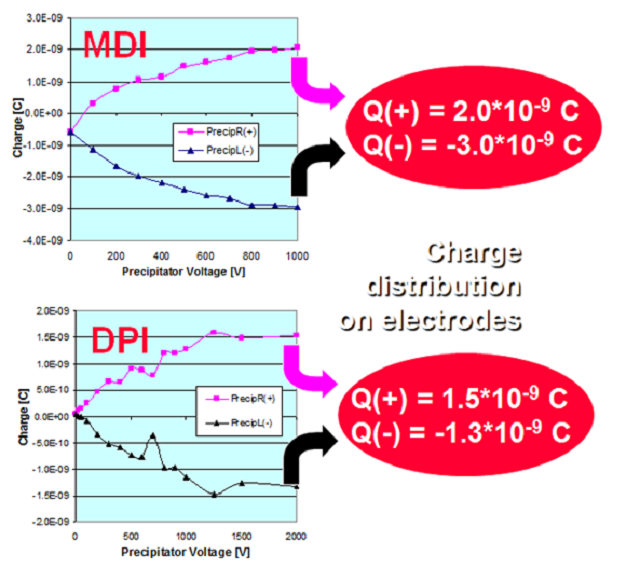
Figure 6. Experimental results
References:
- Jaworek A., Balachandran W., Krupa A., Kulon J., Lackowski M., Wet Electrostatic Scrubbers For Exhaust Gas Cleaning- State of the art. Environ. Sci. Technol., 40 (20), pp. 6197 -6207, 2006.DOI: 10.1021/es0605927
- Jaworek A., Balachandran W., Lackowski M., Kulon J., Krupa A., Multinozzle electrospray system for gas cleaning processes, J.Electrostat. Vol. 64, pp. 194-202, 2006.DOI: 10.1016/j.elstat.2005.05.006
- Kulon J., Malyan B., Balachandran W., Simultaneous Measurement of Particle Size and Electrostatic Charge Distribution in DC Electric Field Using Phase Doppler Anemometry, IEEE Trans. Ind. Applicat., Vol. 39(5), pp. 1522-1528, 2003. 10.1109/TIA.2003.816460
- Balachandran W., Kulon J., Dawson M., Burnell P., Bipolar Charge Measurement of Pharmaceutical Powders, J. Powder Technol. Vol. 135-136, pp. 156-163, 2003. 10.1016/j.powtec.2003.08.011
- Balachandran W.,Jaworek A., Krupa A., Kulon J., M. Lackowski, Efficiency of Smoke Removal by Charged Water Droplets, J. Electrostat. Vol. 58, pp. 209-220, June 2003.
- Kulon J., Malyan B., Balachandran W., “Simultaneous Analysis of Particle Size and Electrostatic Charge Using Phase Doppler Anemometry System,” Proc. of the IEEE IAS 37th Annual Meeting, Pittsburgh, pp. 984-989, USA October 13-18, 2002. 10.1109/IAS.2002.1042677
- Dawson M., Burnell P., Balachandaran W., Kulon J., and Sivathasan S., “A Novel Bipolar Charge Measurement System for Characterising Aerosols,” Proc. of the Respiratory Drug Delivery VIII, pp. 443 – 446, Tucson, Arizona, May 12-16, 2002.
- Kulon J., Hrabar S., Machowski W., Balachandran W., A Bipolar Charge Measurement System for Aerosol Characterization, IEEE Trans. Ind. Applicat., Vol. 37(2), pp. 472-479, 2001. 10.1109/28.913711
- Kulon J., Balachandran W., The Measurement of Bipolar Charge on Aerosols, J.Electrostat. Vol. 51-52, pp. 552-557, 2001. 10.1109/28.913711
- Kulon J., Malyan B., Balachandran W., “The Bipolar Charge Aerosol Classifier,” IEEE IAS 36th Annual Meeting, vol. 4, pp.2241-2248, 30 Chicago USA, Sept.– 4 Oct. 2001. 10.1109/IAS.2001.955936
- Kulon J., Sivathasan S., Dawson M., Sadler R., Balachandran W., “Experimental and Theoretical Study on Deposition of Charged Particles in Horizontal Cylindrical Tubes by Combined Mechanisms,” Proc. of the 4th International Conference on Applied Electrostatics, pp. 90-95, Dalian, China, October 8-12,2001.
